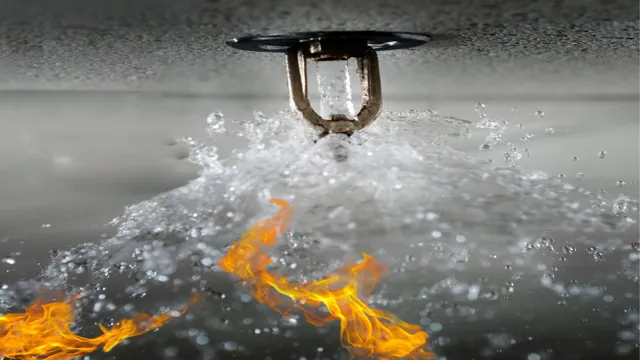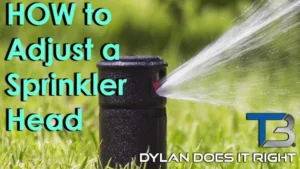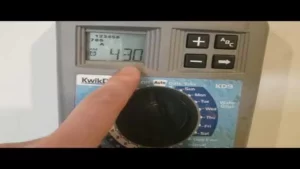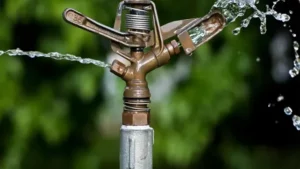As a homeowner or business owner, fire safety should always be a top priority. And one essential component of fire safety is the fire sprinkler system. These systems are designed to automatically detect and extinguish fires, protecting lives and property.
However, just like any other safety equipment, fire sprinkler systems need to be regularly tested and maintained to ensure they are working correctly and efficiently. But how do you test your fire sprinkler system? In this blog, we’ll discuss everything you need to know about testing your fire sprinkler system, including what to look for, when to test, and why it’s so crucial to keep your system in good working condition. By following these tips, you can have peace of mind knowing that your fire suppression system is ready to protect you and your property in the event of a fire.
Gather Necessary Equipment
When it comes to testing a fire sprinkler system, it’s important to have the right equipment on hand. First and foremost, you’ll need a ladder or lift to access the sprinkler heads. Next, you’ll need a flow meter to measure water flow and pressure, and a stopwatch or timer to accurately time the flow rate.
A heat detector or smoke alarm can also be useful for testing the system’s response to a fire. You may also need a set of replacement sprinkler heads in case any are damaged during testing. And don’t forget about personal protective equipment, such as heavy-duty gloves and safety glasses, to ensure your own safety while testing the system.
With the right equipment in tow, you’ll be well-prepared to properly test your fire sprinkler system and keep your property safe in the event of a fire.
Equipment for Testing Sprinkler System
When it comes to testing a sprinkler system, it’s important to have the right equipment on hand. You’ll need a few key items to get an accurate reading of your system’s functionality. These include a pressure gauge, flow meter, and a stopwatch.
The pressure gauge will help you determine the pressure at each point in your system, so you can ensure it’s meeting the necessary requirements. The flow meter will measure the amount of water flowing through your sprinkler system, which is vital information when assessing its effectiveness. Finally, the stopwatch will help you calculate how long it takes for your system to deliver the correct amount of water, so you can be sure it’s working efficiently.
It may seem like a lot, but with the right equipment on hand, testing your sprinkler system can be a simple and stress-free task.

Turn off Water Supply
When it comes to turning off the water supply, it’s important to gather all the necessary equipment beforehand to ensure a smooth process. You don’t want to be running around looking for tools when you have water gushing out of a burst pipe. Some of the equipment you might need includes a pipe wrench, pliers, a bucket, and a towel.
It’s also helpful to have access to the main shut-off valve, which is usually located near the water meter. Turning off the water at the main shut-off valve is the most effective way to stop the flow of water in your home. While it may seem intimidating at first, turning off the water supply is a relatively simple process that can save you from costly water damage in the future.
With the right equipment and a bit of preparation, you’ll be able to handle any plumbing emergency that comes your way.
Preparation for Inspection
When preparing for an inspection, it is important to gather all of the necessary equipment. This includes things like gloves, masks, cleaning supplies, and any specific tools that may be required for your industry. It’s important to make sure that everything is in good condition and ready to use.
You don’t want to end up in a situation where you realize you’re missing something important or that your equipment is damaged. Not only can this cause delays and additional stress, but it can also result in a failed inspection. Think of it like packing for a trip – you don’t want to forget anything important, but you also don’t want to overpack and bring unnecessary items.
By gathering only what you need and ensuring everything is in good condition, you can feel confident and prepared for your inspection.
Checking Alarm and Valve Connections
When it comes to ensuring your building’s safety, testing your fire sprinkler system is crucial. One of the essential steps in testing a fire sprinkler system is to check the alarm and valve connections. The alarm system is the primary way to detect a fire in the building, and it should be checked to confirm that it is working correctly.
The valve connections should also be tested to ensure that they allow water to flow efficiently in the case of fire. To check the alarm system, the fire alarm panel should be inspected to make sure there are no trouble signals present. The valve connections should be checked for any leaks or obstructions that could cause problems during a fire.
By regularly testing the alarm and valve connections, building owners can have peace of mind knowing that their fire sprinkler system is functioning correctly in case of an emergency.
Inspect Control Valves and Alarm Connections
When it comes to maintaining the safety and efficiency of your facility’s plumbing system, inspecting control valves and alarm connections is highly important. These connections ensure that in case of a plumbing emergency, you are immediately notified and the necessary actions can be taken. During the inspection, make sure that all the alarm connections are secure and properly functioning.
Also, check the valves thoroughly to ensure that they are not only functioning properly but also are in good condition. Valve failure can lead to major leaks and other plumbing disasters that may cause significant damage or loss, so it’s essential to conduct regular checks to avoid any disruptions. By doing so, you can catch any potential issues early on and have them resolved quickly, saving your business from expensive repairs.
Remember, a little maintenance now can go a long way in keeping your facility running smoothly and safely.
Ensure Water and Pressure Source is Correct
When it comes to ensuring the proper functioning of your fire alarm and sprinkler systems, there are a few crucial steps to take. One of the most important ones is checking that both the alarm and valve connections are accurate and correctly installed. This means verifying that the water and pressure source feeding into your fire suppression system is correct, as well as making sure that the valves connecting your fire alarm and sprinkler systems are functioning properly.
If any of these pieces are not correctly installed or working, your fire suppression system may not function as intended in the event of a fire. So, it’s essential to take the necessary steps to ensure that everything is in order to keep your home or business safe from potential fire damage. Remember to have a professional fire safety team review your system periodically to guarantee everything is up to code.
Testing the Sprinkler System
If you’re a homeowner or responsible for maintaining a building, it’s important to know how to test a fire sprinkler system to ensure it works properly in an emergency situation. The first step is to turn off the water supply to the system and then open the test valve. This will mimic a fire in the building and activate the sprinkler heads.
Check that all the heads are working and spraying water evenly over the designated area. Additionally, check the pressure gauges to ensure they are reading within the recommended range. If everything looks good, you can turn the water supply back on and conclude the test.
If there are any issues, such as damaged or clogged sprinkler heads or low pressure, it’s important to address them immediately. By regularly testing and maintaining your fire sprinkler system, you can help prevent serious damage or loss of life in case of a fire.
Conduct Dry and Wet Tests
When it comes to ensuring your sprinkler system is functioning properly, testing is crucial. Conducting both dry and wet tests can help you identify any issues with your system and prevent any potential disasters. A dry test involves turning on your system without water to check for any leaks, blockages, or other problems.
Meanwhile, the wet test involves actually spraying water to ensure it is distributed evenly and reaches all areas of your lawn or garden. These tests are important to perform regularly, especially before summer when sprinkler usage is at its highest. By making sure your system is in good condition, you can save money on water bills and ensure your lawn or garden stays healthy and lush.
Overall, testing your sprinkler system is a necessary step to keep your landscaping looking its best.
Record your Test Results
When it comes to testing your sprinkler system, it’s important to record your results in order to make sure everything is working properly. After all, the last thing you want is a malfunctioning system that doesn’t do the job when you need it the most. So, what should you be looking for when testing your sprinkler system? First, make sure that all of the nozzles are spraying in the right direction and at the right pressure.
You should also check for leaks and clogs in the system. Once you’ve completed your testing, be sure to record your results so that you can keep track of any issues that need addressing in the future. By taking the time to test and record your sprinkler system’s performance, you’ll have peace of mind knowing that you’re prepared for any situation that may arise.
Common Issues with Sprinkler Systems
Testing a fire sprinkler system is essential to ensure that it works properly during an emergency. One common issue with sprinkler systems is that they can become clogged with debris, preventing them from functioning correctly. It’s crucial to test the sprinkler system’s water pressure to ensure that it can reach each area of the building.
Another issue that can arise is accidental activation, which can be caused by excess heat, mechanical damage, or even vandalism. Therefore, regular inspections and maintenance are necessary to ensure that the sprinkler system operates correctly. In summary, by testing your fire sprinkler system, you can detect and repair any issues that can prevent it from working correctly during an emergency, providing peace of mind and safety for everyone in the building.
Identifying Common Problems
One of the most common problems associated with sprinkler systems is leakage. Leakage can occur due to a variety of reasons, such as broken pipes, worn-out sprinkler heads, or damaged valves. Leaks can cause significant damage to your lawn and garden over time and can also lead to higher water bills.
Another issue that is frequently encountered is uneven watering. This issue can lead to some parts of your lawn being over-watered, while others are underwatered. This can result in the growth of weed and also lead to water wastage.
Additionally, clogged sprinkler heads can also be a problem, especially if you have hard water in your area. Mineral deposits can build up on the nozzle and restrict water flow, causing uneven or inadequate watering. By regularly inspecting and maintaining your sprinkler system, you can prevent these issues and ensure optimal performance.
Troubleshooting for Common Problems
Sprinkler systems are a convenient and efficient way to keep your lawn and garden healthy. However, they are not immune to common issues like leaks, clogs, and broken components. One common problem that you may experience with your sprinkler system is uneven water distribution.
This can occur due to various reasons such as a broken or clogged nozzle, a damaged sprinkler head, or an underground leak in the system. To troubleshoot this problem, start by inspecting each sprinkler head for damage or clogs. If you notice any issues, clean or replace the nozzle or head.
If the problem persists, it may be time to call in a professional to diagnose and fix the issue before it causes further damage. Remember, routine maintenance and inspections can prevent most common sprinkler system problems, so it’s important to keep a watchful eye on your system and address any issues promptly.
Conclusion
In conclusion, testing a fire sprinkler system is like giving it a virtual parachute jump. You need to make sure that it’s ready to save lives and property in case of emergency. This involves checking all the components, running a series of realistic scenarios, and documenting the results carefully.
A thorough and well-executed test not only gives you peace of mind but also certifies your system’s readiness to take the plunge when it counts the most. So, gear up, test smart, and always remember to keep your safety goggles on!”
FAQs
What is a fire sprinkler system?
A fire sprinkler system is a network of pipes filled with water that is designed to automatically extinguish a fire.
How does a fire sprinkler system work?
A fire sprinkler system activates when the heat from a fire reaches the sprinkler head, causing it to open and release water onto the fire.
How often should a fire sprinkler system be tested?
A fire sprinkler system should be tested at least once a year to ensure that it is functioning properly.
Who should perform fire sprinkler system testing?
Fire sprinkler system testing should be performed by a qualified fire protection professional.
What types of tests are performed on fire sprinkler systems?
Fire sprinkler systems are tested for water flow, pressure, and leakage, as well as to ensure that all sprinkler heads are working properly.
Are fire sprinkler systems required by law?
Fire sprinkler systems may be required by local building codes or insurance companies, but they are not typically required by federal law.
How effective are fire sprinkler systems at extinguishing fires?
Fire sprinkler systems are highly effective at extinguishing fires, with a 96% success rate in controlling or extinguishing fires in buildings with sprinklers installed.






